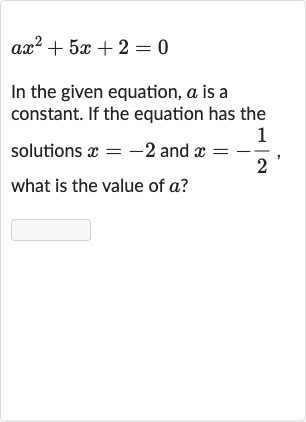Full solution
Q. In the given equation, is a constant. If the equation has the solutions and , what is the value of ?
- Use Factored Form: Let's use the fact that if and are solutions to the equation , then the equation can be factored as .
- Expand and Compare: We can expand the factored form to get the standard form of the quadratic equation. Let's do that:.
- Set Up Equations: Now, we compare the coefficients from the expanded form with the original equation . We have:Coefficient of : (from both equations)Coefficient of : (from the expanded form) and (from the original equation)Constant term: (from the expanded form) and (from the original equation)
- Solve for : Let's set up the equations for the coefficients of and the constant term:
- Check Constant Term: Now, we solve for . Combine like terms in the coefficient equation:
- Check Constant Term: Now, we solve for . Combine like terms in the coefficient equation: Multiply both sides by to solve for :
- Check Constant Term: Now, we solve for . Combine like terms in the coefficient equation: Multiply both sides by to solve for : Now, let's check if the constant term also matches with : The constant term in the expanded form is also , which should be equal to . So, , which is not true. This means there is a mistake in our previous steps.

